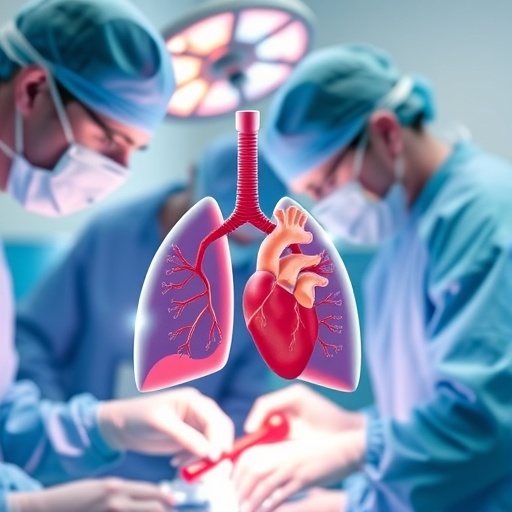In a significant advancement for thoracic surgery and cardiac care, a recent observational study has demonstrated the perioperative safety of simultaneously performing off-pump coronary artery bypass grafting (CABG) alongside pulmonary resection in patients who suffer from both lung cancer and severe coronary heart disease (CHD). This dual-procedure approach addresses one of the most complex clinical challenges faced by surgeons: managing two life-threatening conditions concurrently while minimizing patient risk and optimizing recovery outcomes.
Traditionally, treating patients diagnosed with lung cancer complicated by critical coronary artery disease has posed formidable obstacles. The coexistence of these conditions demands surgical strategies that carefully balance oncological control with cardiovascular stability. Historically, staged surgeries—performing cardiac and pulmonary procedures separately—were the norm despite prolonged hospitalization times and increased overall morbidity. However, the advent of off-pump CABG, which avoids the use of cardiopulmonary bypass, has opened new avenues for integrated surgical interventions.
Off-pump CABG offers substantial advantages by reducing inflammatory response, blood transfusion requirements, and neurocognitive complications often associated with the use of heart-lung machines. When coupled with pulmonary resection, particularly in lung cancer patients, this technique permits simultaneous treatment without the amplified perioperative risks that conventional on-pump surgeries might impose. The observational study, conducted at a single institution, retrospectively evaluated clinical data and patient outcomes, elucidating the feasibility and safety profile of this combined approach.
A key finding from the study was that patients undergoing the dual surgery did not experience a significant increase in perioperative complications compared to those undergoing staged procedures. The incidence of postoperative adverse events, including pulmonary infections, atrial fibrillation, or myocardial infarction, was manageable and aligned with expected outcomes derived from isolated pulmonary or cardiac surgeries. These insights fundamentally challenge prior reservations about the complexity and safety of performing off-pump CABG concurrently with lung resection.
Moreover, the study underlines the economic benefits of the combined surgical technique. By consolidating treatment phases into a single operative session, overall hospitalization duration was notably decreased. This reduction in inpatient days directly correlates with lowered healthcare costs and a decrease in resource utilization—an important consideration given the ever-rising burden on healthcare systems globally. Patients also potentially benefit from a faster return to baseline activity and reduced psychological stress linked to multiple surgeries.
The technical execution of simultaneous off-pump CABG and pulmonary tumor resection requires meticulous preoperative planning and intraoperative coordination. Surgeons must delicately navigate the complex anatomy of the thoracic cavity while ensuring myocardial perfusion remains uncompromised. The off-pump procedure involves stabilization devices and refined suturing techniques to secure grafts on beating hearts, demanding high surgical proficiency. Likewise, pulmonary resection mandates precise oncologic clearance without jeopardizing cardiac function.
This integrated surgical methodology presents a paradigm shift in managing coexistent severe lung malignancy with advanced coronary disease. It highlights the importance of multidisciplinary collaboration, combining expertise from cardiothoracic surgeons, anesthesiologists, pulmonologists, and oncologists to tailor individualized treatment pathways. Identification of suitable candidates hinges upon comprehensive cardiovascular and pulmonary evaluation, leveraging imaging modalities and functional assessments to mitigate intraoperative risks.
While the retrospective nature of the study necessitates cautious interpretation, its findings set a compelling precedent prompting further prospective research. Larger multicenter trials could establish standardized protocols and refine patient selection criteria to solidify the role of simultaneous off-pump CABG and pulmonary resection in clinical practice. In the interim, this approach stands as a promising, safe, and cost-effective option for patients facing the dual burden of lung cancer and severe CHD.
Expanding on the implications of this research, healthcare providers might anticipate a shift towards bundled procedural strategies in complex cardio-oncologic conditions. Such streamlined surgical interventions could redefine perioperative management, heralding improved survival rates and quality of life for a vulnerable patient demographic. Additionally, minimizing perioperative complications translates into reduced reliance on intensive care unit resources, further enhancing hospital efficiency.
The study also draws attention to the evolving capabilities of surgical technology and techniques. Innovations such as minimally invasive thoracoscopic approaches and enhanced cardiac stabilization devices could synergize with off-pump CABG methods, facilitating even less invasive combined surgeries. This confluence of advancements holds the potential to further optimize outcomes while expanding the operative candidacy spectrum.
In summary, the evolving evidence base underscores that off-pump CABG combined with pulmonary resection is not only a technically feasible and safe option but also one that confers tangible benefits in patient recovery and system-level cost containment. This dual-procedure approach marks a pivotal stride towards integrated surgical care for patients grappling with concomitant severe coronary artery disease and lung cancer, charting a course for future innovations in thoracic and cardiac surgery.
—
Subject of Research: People
Article Title: Perioperative safety of simultaneous pulmonary resection and off-pump coronary artery bypass grafting: a retrospective analysis from a single institution
News Publication Date: 11-Feb-2025
Web References: http://dx.doi.org/10.21037/jtd-24-1369
References: Chen F, Gao S, Xia W, Wang M, Zhang W, Xu Y. Perioperative safety of simultaneous pulmonary resection and off-pump coronary artery bypass grafting: a retrospective analysis from a single institution. J Thorac Dis 2025;17(2):650-660. doi: 10.21037/jtd-24-1369
Keywords: Surgery, off-pump CABG, pulmonary resection, lung cancer, coronary heart disease, perioperative safety, thoracic surgery, observational study




